Students can Download 1st PUC Biology Previous Year Question Paper March 2018 (North), Karnataka 1st PUC Biology Model Question Papers with Answers helps you to revise the complete Karnataka State Board Syllabus and score more marks in your examinations.
Karnataka 1st PUC Biology Previous Year Question Paper March 2018 (North)
Time: 3.15 Hours
Max Marks: 70
General Instructions:
- The question paper consists of four parts A, B, C, and D.
- All the parts are compulsory.
- Draw diagrams wherever necessary. Unlabelled diagrams or illustrations do not attract any marks.
Part – A
Answer the following questions in one word / one sentence each: ( 10 × 1 = 10 )
Question 1.
What is a herbarium?
Answer:
It is a storehouse of collected plant specimens that are dried, pressed, and preserved on sheets.
Question 2.
Give an example for palmately compound leaf,
Answer:
Silk cotton tree leaf.
Question 3.
Name the living mechanical tissue.
Answer:
Collenchyma.
Question 4.
Where is nucleolus found?
Answer:
The nucleolus is found within the nucleus.
Question 5.
What is cytokinesis?
Answer:
Division of the cytoplasm is known as cytokinesis.
Question 6.
What happens when fresh grapes are soaked in sugar solution?
Answer:
Grapes become plasmolyzed due to osmosis.
![]()
Question 7.
Define hydroponics.
Answer:
The technique of growing plants in a nutrient solution.
Question 8.
What are alveoli?
Answer:
Structural and functional units of lungs where exchange of gases takes place.
Question 9.
What is a cardiac cycle?
Answer:
The sequential cyclic events of systole and diastole together are known as one cardiac cycle.
Question 10.
Name the structural and functional unit of kidneys.
Answer:
Nephrons.
PART-B
Answer any FIVE of the following questions in 3-5 sentences each, wherever applicable. (5 × 2 = 10)
Question 11.
Write any four characters of fungi.
Answer:
(a) They are heterotrophic eukaryotic organisms either parasites or saprophytes.
(b) They are either unicellular (yeast) or multicellular and filamentous.
(c) The body consists of long slender, thread-like structures called hyphae.
(d) The network of hyphae is called mycelium
(e) Some hyphae of some members are coenocytic.
![]()
Question 12.
Differentiate between Diploblastic and Triploblastic conditions.
Answer:
Animals in which cells are arranged in two embryonic layers namely the outer ectoderm and inner endoderm are called diploblastic animals and the animals in which cells are arranged in three embryonic layers namely outer ectoderm, inner endoderm, and middle mesoderm are called triploblastic animals.
Question 13.
Name the four types of tissues present in the animals.
Answer:
(a) Epithelial tissue
(b) connective tissue
(c) muscular tissue
(d) neural tissue
Question 14.
Draw a neat labeled diagram of mitochondria.
Answer:
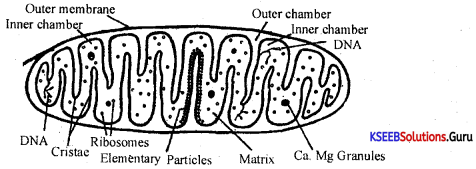
Section through mitochondrion (diagrammatic)
The elementary particles have been shown only on one crista.
Question 15.
What are plant growth inhibitors? Give two examples.
Answer:
The hormones which inhibit (retard) growth rate are called growth inhibitors, e.g.: Abscisic acid (ABA) & ethylene.
Question 16.
Define (a) Tidal Volume (b) Expiratory Capacity.
Answer:
(a) Tidal volume: Volume of air inspired or expired during normal respiration.
(b) Expiratory capacity: Total volume of air a person can expire after a normal inspiration.
Question 17.
What are Urecotelic animals? Give an example.
Answer:
Animals that excrete nitrogenous wastes as uric acid are called Uriotelic animals.
e.g. reptiles, birds.
Question 18.
What is osteoporosis? Mention the common cause that leads to Osteoporosis.
Answer:
Osteoporosis is an age-related disorder characterized by decreased bone mass and increased chances of fracture. Decreased level of estrogen is the main cause.
PART-C
Answer any FIVE of the following questions in 40 to 80 words each, wherever applicable. (5 × 3 = 15)
Question 19.
Write the taxonomic hierarchy of man.
Answer:
Kingdom – Animalia
Phy/Div – Chordata
Class – Mammalia
Order – Primates
Family – Hominidae
Genus – Homo
Species – sapiens
![]()
Question 20.
What is phyllotaxy? Explain any two types.
Answer:
The pattern of arrangement of leaves on the stem or branches is known as phyllotaxy.
Types:
(a) Alternate: Only one leaf at each node is arranged alternately.
(b) Opposite: The leaves are arranged in pairs at each node opposite to each other.
(c) Whorl: Three or more leaves arise at each node in whorls.
Question 21.
List any three differences between tracheids and trachea.
Answer:
Tracheids
(a) Primitive in origin
(b) cells are elongated with tapering ends.
(c) cells are longer in length
(d) possess narrow lumen
(e) less thickened secondary wall
(f) less efficient in conduction
Question 22.
Name the five sub-phases of prophase – I in meiosis.
Answer:
(a) leptotene
(b) zygotene
(c) pachytene
(d) diplotene
(e) diakinesis
Question 23.
List any three applications of auxins.
Answer:
Auxins:
- Auxiñs were the first hormones to be discovered in plants.
- F.W. Went confirmed and isolated the auxins from coleoptiles of Avena saliva.
- Chemically it ¡s called Indole-3-Acetic Acid and is derived from amino acid tryptophan.
- Auxins can stimulate cell division, cell elongation, and cell maturation.
- It promotes Apical dominance.
- It initiates Root formation.
- Can promote parthenocarpy.
- Prevent premature fall of flowers, buds, and leaves.
- 2, 4D, and 2,4,5T are used as selective weedicides.
- Promote phototrophic and hydrotropic movements.
- Promote xylem differentiation.
Question 24.
Mention the three major types of cells present in gastric glands. Give their secretions.
Answer:
(a) Parietal /oxyntic cells – secrete HCl and intrinsic factor
(b) Peptic cells/chief cells – proenzyme, pepsinogen
(c) mucus neck cells – secrete mucus.
Question 25.
What is systemic circulation? Write the pathway diagram of systematic circulation.
Answer:
The circulation of blood between the heart and all body parts.
![]()
Question 26.
Write the names of bones or the forelimb of man.
Answer:
Humerus, radius, ulna, carpals, metacarpals, and phalanges.
Part-D ( Section -I ).
I. Answer any FOUR of the following questions in 200-250 words each. ( 4 × 5 = 20 )
Question 29.
Draw a neat labeled diagram of the digestive system of cockroaches.
Answer:
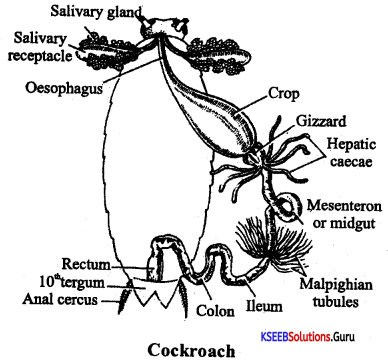
Question 30.
What is centromere? Explain the types of chromosomes based on the position of the centromere.
Answer:
Primary constriction of the chromosome (or) The region where kinetochores are present is known as the centromere.
Types of Chromosomes:
I. Classification of chromosomes based on the number of centromeres
(a) Aceidric chromosome: It is a chromosome without centromere.
(b) Monocentric chromosome: Here there is one centromere to hold the chromatids together.
(c) Ilicentric chromosome: It is the presence of two centromeres in a chromosome.
(d) Polvcentric chromosome: It is more than three centromeres in a chromosome.
II. Classification of chromosomes based on the position of centromere:
(a) Metacentric type
Here the centromere is exactly at the center of two chromatids. It looks V-shaped during anaphase.
(b) Sub metacentric type
Here the ‘centromere is eccentric in position so that one of the chromatids is long and the other is shorter. It looks L – shaped during anaphase.
(c) Acrocentric type
Here the centromere is almost towards one end of the chromatid to form a very long arm and another very short arm. It looks hook-shaped during anaphase.
(d) Telocentric type
Here the centromere is towards one end of the chromatid such that one chromatid is only present. It looks rod-shaped during anaphase.
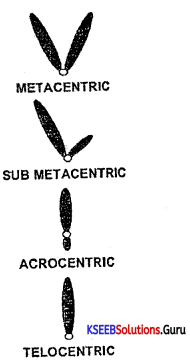
III. Classification of chromosomes based on their functions:
(a) Autosomes [AA]: They are also called somatic chromosomes that control body characteristics.
(b) Allosomes [X or VI]: They are also called sex chromosomes that determine the gender of an individual.
Functions of chromosomes:
- Chromosomes are very important in the higher animals for the phenomenon of sex determination.
- Chromosomes play an active role in the metabolic process of a cell.
- They carry the heredity information from parents to offspring in the form of genes.
![]()
Question 31.
Explain the classification of enzymes.
Answer:
- Oxidoreductases: Act on many chemical groupings to add or remove hydrogen atoms.
- Transferases: Transfer functional groups between donor and acceptor molecules. Kinases are specialized transferases that regulate metabolism by transferring phosphate from ATP to other molecules.
- Hydrolases: Add water across a bond, hydrolyzing it.
- Lyases: Add water, ammonia, or carbon dioxide across double bonds, or remove these elements to produce double bonds.
- Isorne rases: Carry out many kinds of isomerization: L to D isomerizations. Mutase reactions (shifts of chemical groups) and others.
- Ligases: Catalyze reactions in which two chemical groups are joined (or ligated) with the use of energy from ATP.
Question 32.
Describe the thistle funnel experiment to demonstrate osmosis with a labeled diagram.
Answer:
Thistle Funnel Experiment: Take a thistle funnel having a long stem. Close the mouth of the funnel with a membrane of animal bladder or parchment paper by means of a thread.
Pour 10% sugar solution in the thistle funnel till it stands at about 1/3 of the height of the stem. Now dip the covered end of the thistle funnel in a beaker containing water. Support it in its position by means of a stand. Mark the level of sugar solution as A by means of glass marking pencil or gummed paper. Note that after a few minutes the level of the sugar solution has risen in the stem of the thistle funnel to a point B.
Results: The rise of sugar solution in the thistle funnel can only be due to the entry of water into it through the animal bladder.
Section – II
II. Answer any THREE of the following questions in 200-250 words each, wherever applicable. (5 × 3 = 15)
Question 33.
Give the schematic representation of the nitrogen cycle.
Answer:
Nitrogen Cycle:
- Nitrogen ¡s a limiting nutrient for both natural, and agricultural ecosystems.
- It exists as two nitrogen atoms held together by strong triple covalent bonds (N = N).
- The nitrogen cycle involves the following steps:
1. Nitrogen fixation
2. Ammonification
3. Nitrification and
4. Denitrification.
Question 34.
Describe the structure of chloroplast with a neat labeled diagram.,
Answer:
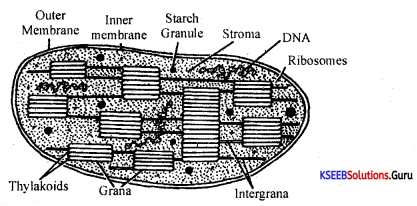
Electron microscopic structure of the chloroplast
Chlorophyll-containing plastids are called Chloroplasts. They are present in the cells of all green plants and abundant in the leaf mesophyll cells. They are elliptical or oval in shape.
Chloroplast is bounded by two membranes with the intermembrane space called peri plastidial space, containing peri plastidial fluid. ¡t is made up of H2O, mineral ions, proteins, etc. It is a lubricating fluid that avoids friction between the two membranes. The inner chamber is filled with a colorless proteinaceous fluid matrix called the stroma. Besides abundant proteins, stroma contains 70s ribosomes, circular DNA, and all the enzymes of the Calvin cycle.
Embedded in the stroma, there are green-colored bodies called grana, which are interconnected by frets. Grana is the site of light reaction, each granum consists of a stack of lipoprotein membrane discs called Thylakoids. Each thylakoid contains several photosynthetic centers called Quantasomes. Each quantasome contains about 250 chlorophyll pigments and a few xanthophylls and carotenes.
Only chlorophyll- is capable of harvesting light energy into photosynthesis and hence it is called the primary photosynthetic pigment. All the other pigments, merely absorb light energy and pass it on to chlorophyll, and hence are called accessory photosynthetic pigments.
Note: As chloroplasts contain circular DNA 70s ribosomes and as they go for protein synthesis, they are regarded as semi-autonomous cell organelles.
![]()
Question 35.
Write the schematic representation of the steps of glycolysis.
Answer:
- It occurs in the cytoplasm of the cell.
- It is an enzymatic reaction, thus temperature sensitive.
- It is a common reaction for both aerobic and anaerobic respiration.
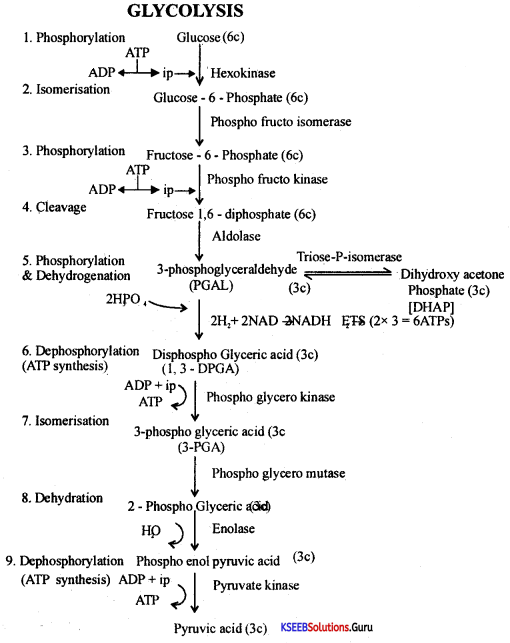
Question 36.
Draw a neat labeled diagram of multipolar myelinated neurons.
Answer:
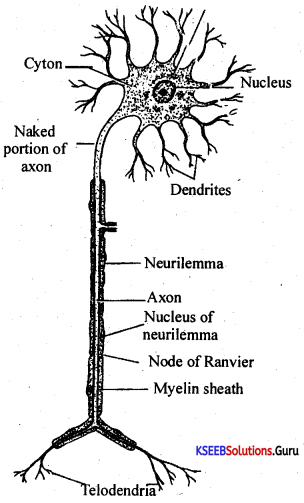
Question 37.
List the hormones secreted by the anterior lobe of the pituitary with one function of them.
Answer:
1. Somatotrophic hormone or Human growth hormone (STH or HGH): Promotes the growth of muscles. It stimulates the uptake of amino acids by tissues and their synthesis into proteins.
- Hypo secretion in childhood causes Pituitary dwarfism. Such an individual will be abnormally dwarf and is called a midget.
- Hypersecretion in childhood causes Pituitary gigantism. Such an individual will be abnormally tall.
- Hypersecretion in adolescence causes acromegaly which is characterized by the formation of disproportionately large hands, feet, cheekbones, jaws, etc.,
2. Thyroid-stimulating Hormone (TSH): Controls secretion of thyroid hormones by the thyroid gland and also regulates iodine intake by the thyroid gland.
- Hypo secretion leads to goiter, cretinism, and myxoedema.
- Hypo secretion leads to hyperthyroidism.
3. Adrenocorticotrophic hormone (ACTH): It controls the secretion of hormones (Cortisone) by the adrenal cortex.
- Hypersecretion of ACTH causes Cushing’s syndrome.
- Hypo secretion causes Addison’s disease.
4. Follicle Stimulating Hormone (FSH): In females the induces growth and maturation of Graffian follicle and stimulates follicular secretion of estrogen. In males, it stimulates the testis to produce sperm.
5. Luteinizing Hormone or Interstitial Cell Stimulating Hormone (EH or ICSH): In females, it stimulates ovulation and the formation of the corpus luteum. In males, it stimulates interstitial cells in the testis to secrete testosterone.
6. Prolactin or Lactogenic or Luteotropic Hormone (LTH): In females, it causes growth and development of breasts during pregnancy. It stimulates milk production and secretion after childbirth, it inhibits ovulation during pregnancy and breastfeeding.
7. Melanocyte Stimulating Hormone (MSH): Increases skin pigmentation by stimulating dispersion of melanin in amphibians but its exact role in humans is unknown.